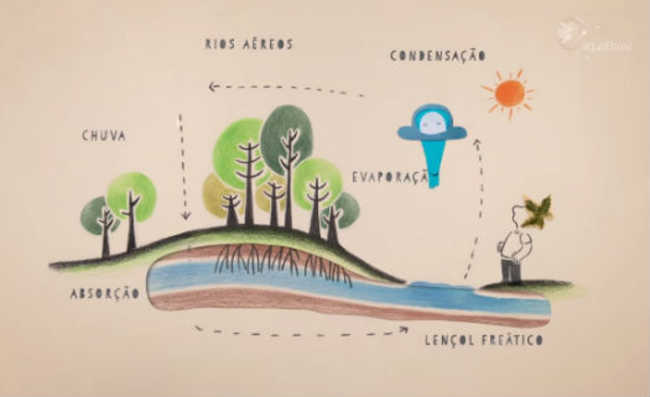Chlorpyrifos, a dangerous pesticide on your table
Understand the use of chlorpyrifos, how it works in your body and ways to avoid it

Chlorpyrifos is an organophosphate pesticide classified as insecticide, anticide and acaricide. Crystal clear and toxic, it is used to control pests such as mosquitoes, cockroaches, larvae, jumping beetles and fire ants.
- Organophosphates: what they are, symptoms of intoxication, impacts and alternatives
- Learn how to make natural insecticide and pest control in the garden
- What is the trophobiosis theory
Organophosphate pesticides, primarily used as chemical weapons, are classified in pharmacology as anticholinesterases, that is, agents that affect the functioning of the neurotransmitter acetylcholine, involved in memory and learning.
These "poisons" are widely used all over the world, mainly in developing countries. Brazil is one of the countries that most uses this product, as indicated in the article “Dossier indicates Brazil as the country that most uses pesticides in the world”, having its use increased by 162% in 12 years. In 2009, the country reached the first place in the ranking consumption of pesticides, even without occupying the position of largest agricultural producer in the world.
The consumption of this “agricultural defender” - a euphemism used by companies that sell these products - is worrying and brings many negative consequences. According to data from the National Toxic-Pharmacological Information System (Sinitox), 26,385 cases of poisoning by agricultural pesticides were registered in the period 2007-2011. In 2009, its use exceeded five thousand tons of active principles in 726,017 hectares of planted area.- Organic urban agriculture: understand why it's a good idea
- Allelopathy: Concept and Examples
- what is agroecology
Use
Named by the International Union of Pure and Applied Chemistry (Iupac) as O,O-diethyl O-3,5,6-trichloro-2-pyridyl phosphorothioate, or C9H11Cl3NO3PS, chlorpyrifos is a virtually insoluble white crystalline solid in water. It is used through foliar application in cotton, potato, coffee, barley, citrus, beans, apple, corn, pasture, soy, sorghum, tomato crops (authorized use only for ground tomato, for industrial purposes) and wheat; by localized application in the banana crop (bag to protect the bunch); by soil application in potato and maize crops; and also in ant control, in the form of granulated bait.
In 2001, the United States restricted domestic use of the substance after the country's Environmental Protection Agency (EPA) demonstrated that exposure to low concentrations of chlorpyrifos can interfere with the development of the nervous system in mammals, in addition to being related to the occurrence of low birth weight and small heads in newborns. Due to the high risk to children's health, all registrations of products containing chlorpyrifos for residential use were canceled, with the exception of baits for application in the control of cockroaches that are equipped with safety devices to protect children and animals from any exposure to the ingredient asset used. From this ban, the increase in the weight of newborns in the country was noticed.
- Organic cotton: what it is and its advantages
- How to get rid of ants naturally
In Europe, the use of this pesticide has been phased out since 2006, and in the US it is only allowed to combat pests on farms, being used for the production of approximately 50 crops. In 2017, US chemical experts tried to ban its use because of the possible harm, but the EPA president rejected the proposals, keeping the use allowed.
In Brazil, in 2004, the National Health Surveillance Agency (Anvisa) adopted the same measure as the EPA in this regard, so that in the country chlorpyrifos is allowed for agricultural use and restricted to domestic use. The regulation took place through Resolution - RDC n°226, of September 28, 2004.
Effects on human health
Chlorpyrifos is a flammable substance that can cause serious intoxications, being absorbed through the oral, cutaneous and respiratory routes. Inhalation or ingestion of chlorpyrifos affects the nervous system and causes, depending on the dose and duration of exposure, from headaches to unconsciousness.
According to the International Agency for Research on Cancer (IARC, its acronym in English), chlorpyrifos is an insecticide associated, in several group studies carried out with product applicators, with an increased risk of leukemia and non-Hodgkin's lymphoma. Mechanical studies indicated that the substance is toxic to genes, immune system and affect cell proliferation and survival.
There are also studies showing that exposure to chlorpyrifos can progressively decrease neuronal capacity, since the pesticide alters the functioning of microtubules, fundamental filaments for the division and maintenance of cell structures, affecting proteins related to them.
Furthermore, according to a review by Eaton et al. (2008), the pesticide was shown to be neurotoxic, disrupting the thyroid hormone axis of mice exposed during intrauterine life. Chlorpyrifos also interfered with the male reproductive system of rats that came into contact by oral ingestion, induced alterations in testicular tissue and led to a decrease in sperm count and animal fertility.
In Brazil, in 1999, a collective contamination caused the intoxication of 112 employees in a hospital in Porto Alegre due to the use of the insecticide. The "poison" was used in eight community health centers and had its operation resumed even with strong odor and product puddles in these places, causing contamination. Intoxicated people still suffer serious consequences such as: changes in the menstrual cycle, fatigue, muscle pain, nightmares, insomnia, irritability, skin lesions, thyroid dysfunction, liver problems, depression and even suicide attempts (see more about the damage caused by pesticides can cause in our article “The damage caused by the use of pesticides in the world and in Brazil”).
Mechanism of action
The mechanism of action of chlorpyrifos occurs through the inhibition of acetylcholinesterase (AChe), an enzyme responsible for hydrolyzing acetylcholine (Ach), a neurotransmitter involved in memory and learning. The insecticide binds to the esterase center of AChe, making it impossible for it to perform its function of hydrolyzing the neurotransmitter Ach into choline and acetic acid. The inactivation of Ach causes it to act longer and with greater intensity on nerve synapses (cholinergic overstimulation). The longer permanence of Ach in synaptic clefts potentiates parasympathetic effects, such as ocular miosis, nausea, vomiting, diarrhea, among others.
The duration of the effects is determined by the product's properties (solubility in lipids), by the stability of its union with acetylcholinesterase and by the aging or not of the enzyme. Inhibition of Ach is initially done by a temporary ionic bond, but the enzyme is gradually phosphorylated by a covalent bond over 24 to 48 hours (“enzyme aging”) and when this occurs, the enzyme no longer regenerates.
The inhibition caused by the compound tends to be irreversible without the correct treatment. The rate of regeneration, however, varies according to the process of “aging” of the enzyme. When the point of irreversibility is reached, it can result in a cumulative effect if recurrent exposure to the compound occurs. So, intoxication depends not only on the intensity of exposure, but also on the rate of enzyme regeneration.
Impacts on the environment
Chlorpyrifos is classified by the Ministry of Health as highly toxic (Class II). In the environment, this pesticide is affected, in addition to its physical properties, by the characteristics of the soil, application practices and environmental conditions, such as wind, temperature and humidity.
In nature, chlorpyrifos has a high degree of volatility (1.9 x 10-5 mmHg/ 25°C), which makes it highly dispersive in the environment. Its degradation and that of its metabolites in the soil occurs mainly by photocatalysis, with a half-life that can vary from 60 to 120 days, depending on factors such as soil pH, temperature, climate, humidity and organic carbon content.
In the aquatic environment, it is highly toxic to algae, crustaceans and fish. In July 2013, in the Kennet River, a contamination by half a cup of this pesticide while washing a drain was enough to poison insects and shrimp for a radius of approximately 15 km. This compound appears to be absorbed by most aquatic animals directly from water, rather than ingesting from the diet or through exposure to contaminated sediment.
In the terrestrial environment, earthworms and bees are the animals that suffer the greatest impact. Earthworms due to direct contact with contaminated soil and bees by ingesting pollen from contaminated fruits. In a review study carried out in the USA, Brazil, India and several other European countries, contamination by chlorpyrifos was observed in almost 15% of the hive pollen samples and just over 20% of the honey samples. Due to this high prevalence of chlorpyrifos in pollen and honey, it is observed that bees are more impacted by this pesticide than by others.
- The importance of bees to life on the planet
When exposed in the laboratory to the levels found in the study, the bee larvae had a 60% mortality rate within a six-day period, compared to 15% mortality in the control group. Adult bees exposed to sublethal effects exhibited altered behaviors, began to travel shorter distances, had greater difficulty in straightening, unusual abdominal spasms and more grooming (detection and removal of ectoparasitic mites). Furthermore, chlorpyrifos chloride appears to inhibit acetylcholinesterase in bee intestinal tissue as opposed to head tissue.
How to avoid its consumption
Chlorpyrifos, as well as several other insecticides, is widely used in the production of conventional (non-organic) foods. These pesticides are used largely indiscriminately, harming the health of those who consume them and the environment.
Some researchers are working on developing alternatives to the use of pesticides, using biological techniques such as fungal encapsulation. However, while the use of these technologies is not widespread, the solution to avoid their consumption is to use natural alternatives to rid your food of pesticides in a healthy way or consume organic foods.
In the production of organic food, the farmer makes use of techniques such as adjusting the food production to the planting location, using natural predators to get rid of pests, alternating cultivation and using fertilizers and natural fertilizers, so that they are cultivated foods that are not harmful to health and the environment.










